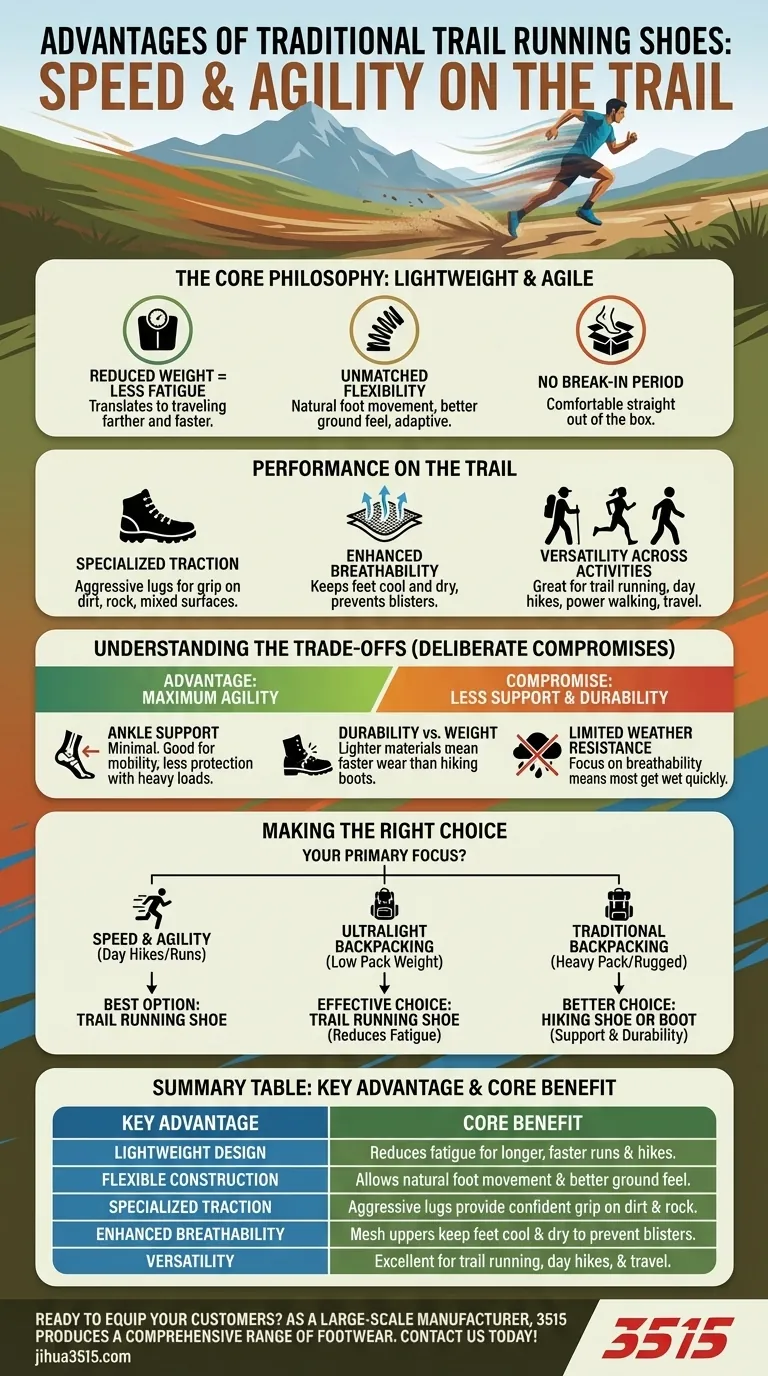At their core, traditional trail running shoes deliver a distinct advantage in speed and agility on the trail. They achieve this through a lightweight and flexible design that provides excellent traction and shock absorption, allowing you to move quickly and efficiently over varied terrain without the weight and rigidity of traditional hiking footwear.
The fundamental advantage of a trail running shoe is its emphasis on minimizing weight and maximizing flexibility. This design philosophy makes it the superior choice for fast-paced movement where ankle support and absolute durability are secondary concerns.

The Core Philosophy: Lightweight and Agile
The primary benefits of a trail running shoe stem directly from its design goal: to be a running shoe built for the dirt. This informs every aspect of its construction, from weight to feel.
Reduced Weight for Less Fatigue
A core principle in outdoor footwear is that weight on your feet costs significantly more energy than weight on your back. Trail running shoes are exceptionally light, which translates directly to less fatigue over miles of running or hiking, allowing you to travel farther and faster.
Unmatched Flexibility
Unlike stiff hiking boots, trail runners are designed to be flexible. This allows your foot to move naturally, providing a better feel for the ground beneath you and enabling quick, adaptive movements on uneven surfaces.
No Break-In Period
Thanks to their flexible materials and sneaker-like construction, most trail running shoes are comfortable and ready for use straight out of the box. This eliminates the long and often painful break-in period required for traditional leather hiking boots.
Performance on the Trail
While built on a lightweight frame, trail runners incorporate specific features to handle the unique demands of off-road terrain.
Specialized Traction
The outsoles of trail running shoes feature aggressive lugs designed to grip dirt, rock, and mixed surfaces. This provides confident traction for running both uphill and downhill, prioritizing grip for agile movement.
Enhanced Breathability
Most traditional trail runners use mesh uppers that provide excellent ventilation. This breathability helps keep your feet cooler and drier from sweat, which is a critical factor in preventing blisters during high-exertion activities.
Versatility Across Activities
The combination of comfort, light weight, and traction makes these shoes highly versatile. They are not only perfect for their intended purpose but also excel for day hikes, power walking, and even as a comfortable all-around travel shoe.
Understanding the Trade-offs
To appreciate the advantages of trail running shoes, it is crucial to understand the deliberate compromises made in their design. They are specialized tools, not a one-size-fits-all solution.
The Ankle Support Compromise
Trail runners offer minimal to no ankle support compared to hiking boots. This is an intentional trade-off. The low-cut design allows for maximum ankle mobility, which is essential for a runner's natural gait, but offers little protection against twists or sprains when carrying a heavy load.
Durability vs. Weight
To achieve their low weight, these shoes use lighter materials. While more durable than a standard road running shoe, they are significantly less durable than a purpose-built hiking shoe or boot. Expect them to wear out faster, especially when used on highly abrasive rock or for high-mileage activities.
Limited Weather Resistance
The focus on breathability means most standard trail running shoes are not waterproof and offer very little insulation. They will get wet quickly and are not ideal for very cold or consistently wet conditions, though waterproof versions are available.
Making the Right Choice for Your Goal
To decide if a trail runner is right for you, consider the balance between speed and support your activity demands.
- If your primary focus is speed and agility on day hikes or trail runs: A trail running shoe is almost certainly your best option.
- If your primary focus is ultralight backpacking with a low pack weight: Trail runners are a popular and effective choice that reduces overall fatigue.
- If your primary focus is traditional backpacking with a heavy pack or hiking in rugged terrain: A dedicated hiking shoe or boot will provide the necessary support and durability that a trail runner lacks.
Choosing a trail running shoe is a deliberate choice for nimble, fast-paced movement over maximum protection.
Summary Table:
| Key Advantage | Core Benefit |
|---|---|
| Lightweight Design | Reduces fatigue for longer, faster runs and hikes. |
| Flexible Construction | Allows natural foot movement and better ground feel. |
| Specialized Traction | Aggressive lugs provide confident grip on dirt and rock. |
| Enhanced Breathability | Mesh uppers keep feet cool and dry to prevent blisters. |
| Versatility | Excellent for trail running, day hikes, and travel. |
Ready to equip your customers with high-performance trail running footwear?
As a large-scale manufacturer, 3515 produces a comprehensive range of footwear for distributors, brand owners, and bulk clients. Our production capabilities encompass all types of shoes and boots, including specialized trail running models designed for speed, agility, and durability. We can help you source or develop the perfect footwear to meet market demand.
Contact us today to discuss your manufacturing needs and bring superior trail running shoes to your market!
Visual Guide

Related Products
- Wholesale Breathable Training Shoes Custom Athletic Footwear Manufacturer
- Lightweight Breathable Training Shoes for Wholesale & Custom OEM Manufacturing
- Wholesale Breathable & Cushioned Training Shoes Custom Factory Production
- Durable Rubber-Soled Utility Shoes for Wholesale & Custom Brand Manufacturing
- Wholesale Training Shoes with Dial Lacing System Custom OEM Manufacturing
People Also Ask
- What are the benefits of athletic-style work shoes? Boost Comfort and Safety for Your Team
- What are the benefits of breathable mesh in shoe design? Enhance Comfort and Performance
- What should be considered when choosing smart trainers for business casual? A Guide to Professional Style
- Does more ground contact area mean better support? Unlock the Secrets of Stable Footwear
- What are the benefits of breathable materials in work shoes? Enhance Comfort & Health for Your Workforce



















